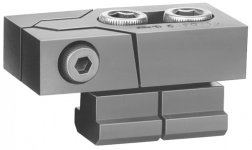Hello everybody. My first post and first large part on new machine.
Machine is CNC VTL with C axis and live tooling. Table diameter is 1600mm(63in) with 4 independent jaws and t-slots.
Part is 1.4404 stainless steel plate 1195mm(47.04in) in diameter, 18mm(0.708in) thick with 359mm(14.13in) hole. Raw stock is 20mm thick plate cuted with water so I only have 2mm(0.079in) allowance on thickness. There is some allowance on OD and ID.
Tolerance on flatness and paralelism is 0.3mm(0.0118in).
On OD I need to turn 20 degree taper 15.5mm(0.61in) long.
There are also some holes and face grooves on one side.
How do I approach this job? What to do and what to avoid? Clamping, setup?
Im operating this machine for couple months and before this I worked on CNC lathe with 12in chuck so this is pretty different and chalenging.
Machine is CNC VTL with C axis and live tooling. Table diameter is 1600mm(63in) with 4 independent jaws and t-slots.
Part is 1.4404 stainless steel plate 1195mm(47.04in) in diameter, 18mm(0.708in) thick with 359mm(14.13in) hole. Raw stock is 20mm thick plate cuted with water so I only have 2mm(0.079in) allowance on thickness. There is some allowance on OD and ID.
Tolerance on flatness and paralelism is 0.3mm(0.0118in).
On OD I need to turn 20 degree taper 15.5mm(0.61in) long.
There are also some holes and face grooves on one side.
How do I approach this job? What to do and what to avoid? Clamping, setup?
Im operating this machine for couple months and before this I worked on CNC lathe with 12in chuck so this is pretty different and chalenging.




